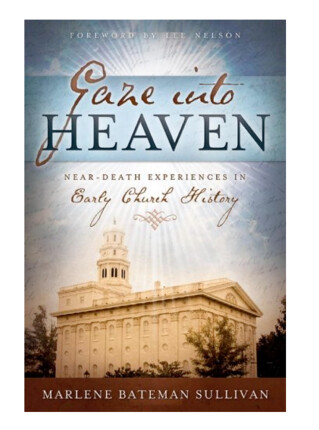Job posed the question of the ages when he asked: “If a man die, shall he live again?” (Job 14:14).
Jesus Christ answered, saying; “Because I live, ye shall live also” (John 14:19). Like birth, death is a necessary step in our eternal progression—a doorway that leads into the next life. The written accounts we have of early Latter-day Saints visiting the spirit world stand as a witness that life does not end with death. When the Savior came to earth, died, and rose again, He opened the doors of salvation, breaking the bands of death so that we might live.
Brigham Young said, “Our bodies are composed of visible tangible matter . . . What is commonly called death does not destroy the body, it only causes a separation of spirit and body, but the principle of life, inherent in the native elements, of which the body is composed, still continues” (Discourses of Brigham Young, compiled by John A. Widstoe, (Salt Lake City: Deseret Book 1954), pp. 368-369).
Since none of us has died, death remains unfamiliar and unknown. However, a few people have visited the spirit world through near-death experiences, dreams, and visions. We can learn much about death and the next life from their accounts.
We Are Not Left Alone When We Die
One such insight we learn from these accounts is that in the first moments after death, newly-departed spirits are often met by a guide who escorts them to the spirit world.
Lorenzo Dow Young, who had a near-death experience in the early 1800s, said:
“In a moment I was out of the body, and fully conscious that I had made the change. At once, a heavenly messenger, or guide, was by me. I thought and acted as naturally as I had done in the body, and all my sensations seemed as complete without as with it,” he went on to say, “the personage with me was dressed in the purest white. My guide, for so I will call him, said ‘Now let us go’” (Marlene Bateman Sullivan, Gaze Into Heaven; Near-death Experiences in Early Church History, (Springville, Utah: Cedar Fort, Inc., 2013), 27-30).
Tom Gibson, who had a near-death experience following a heart attack, shared that his friend Daniel came to escort him to the spirit world. He wrote:
“The world was different from this one. I’m not sure how I got there . . . I just followed Daniel. It seems as if all I had to do was think of where I wanted to be, and I could go there at any speed I wished. . . We continued walking for a while and I noticed someone on the path ahead of us. . . As we got closer to the individual on the path, I could see and feel that he was a magnificent person, and it was . . . I felt overwhelmed as I looked at him. He was bathed in light. Daniel asked if I knew who that was, and I answered, yes; it was Jesus Christ.
“When we got close to the Savior, I felt a tremendous love emanating from him. It’s hard to describe, but you could feel it all around him, and I felt a similar enormous love for him. I fell at his feet—not because I thought about it, but because I couldn’t stand” (Marlene Bateman Sullivan, Gaze Into Heaven; Near-death Experiences in Early Church History, op cit. pp. 89-90).
It is comforting to know that loved ones or angels will greet us when we leave our mortal bodies and help us know where to go.
► You'll also like: Life After Death: 6 Insights into the Spirit World
The Spirit World Will Be Glorious but Familiar
It is natural to be curious about what the spirit world looks like. Some people who visited there have given clear and vivid descriptions, such as Brother Pettersson, who said it resembled the world he knew on earth. He wrote:
“There were cities and villages, lakes and rivers, fields and gardens, houses and mansions, temples and palaces, flowers and animals of great beauty and variety. The people were busy. Some were building, some were planting, some harvesting” (Marlene Bateman Sullivan, The Magnificent World of Spirits; Eyewitness Accounts of Where We Go When We Die, (Springville, Utah: Cedar Fort, Inc., 2016), 87-92).
In 1867, John Powell wrote:
“My spirit then left my body and went with my guide . . . Here I beheld the inhabitants. The houses and trees were beautiful to behold. I was so amazed and so delighted that I requested my guide to permit me to stay and dwell there, for all things were far in advance of this world” (Ibid., 84-85).
Tom Gibson, whose near-death experience was mentioned before, also described these surroundings:
“Daniel next led me to a city. It was a city of light—similar to cities on earth in that there were buildings and paths; but the buildings and paths appeared to be built of materials which we consider precious on earth. They looked like . . . that is they resembled marble, and gold, and silver, and other bright materials, only they were different—the buildings and streets seemed to have a sheen, or to glow. The entire scene was one of indescribable beauty. . .
“There was another feeling that went with it. On earth there always seems to be something . . . you know how things bother you here. There is always some problem troubling you. Either its health, or money, or people, or war, or something. That was missing there. I felt completely at peace, as if there were no problems which were of concern. It wasn’t that there were no challenges—it’s just that everything seemed to be under control. It was such a wonderful feeling that I never wanted to lose it” (Marlene Bateman Sullivan, Gaze Into Heaven; Near-death Experiences in Early Church History, op cit. pp. 89-90).
There Will Be No Strangers
President Spencer W. Kimball taught us that familial relationships and friendships forged on earth will continue on in the next life. He said:
“To the unbeliever [death] is the end of all, associations terminated, relationships ended, memories soon to fade into nothingness. But to those who have knowledge and faith in the promise of the gospel of Jesus Christ, death’s meaning is . . . a change of condition into a wider serener sphere of action; it means the beginning of eternal life” (Edward Kimball, (compiled and edited), Teachings of Spencer W. Kimball, (Salt Lake City: Bookcraft, 1982), 39).
Thomas S. Thomas also testified that relationships endure beyond this life. He declared:
“The grand greeting you first receive is from your closest of kin—father, mother, brother and sisters—and all that are near and dear to you who passed from earthly life and arrived in the Great Beyond before you.”
He continued, “I realized that I met no strangers in the meeting and greeting of the millions of souls there. . . . There were two groups of souls I met there. One group had been to earth and departed before me from there, and the other group was waiting their chance to go to earth. None of either of these were strangers to me; I had always known them” (Marlene Bateman Sullivan, Gaze Into Heaven; Near-death Experiences in Early Church History, op cit., 98-102).
Death is Not a Thing to Fear
We need not fear death, for when we depart this life, we will be freed from earthly pain and filled with joy. Brigham Young said:
“We shall turn round and look upon it [death] and think, when we have crossed it, why this is the greatest advantage of my whole existence, for I have passed from a state of sorrow, grief, mourning, woe, misery, pain, anguish and disappointment into a state of existence where I can enjoy life to the fullest extent as far as that can be done without a body” (Brigham Young, Journal of Discourses, vol. 17, 26 volumes, (Liverpool, 1854-86), 142).
Just as a mother forgets the pain of childbirth once her child is in her arms, so we will forget the pains of earth life and find comfort and joy.
Thomas S. Thomas also spoke of this:
“All mental powers were restored. The fond memories of the past returned . . . your soul is endowed with wisdom and knowledge and filled with everlasting love. . . . Distance is no barrier to transmit thought without instruments, or to travel under your own power. Your vision is magnified there; your future view is plain; desire for knowledge is inexhaustible; you are master of yourself; intelligence is the key to all realms which makes an endless trail to all advancement and is a place of satisfaction and joy to the soul. . . . to the soul. . . . Time is figured on a different basis than in earthly life” (Marlene Bateman Sullivan, Gaze Into Heaven; Near-death Experiences in Early Church History, op cit., 98-102).
Death Brings with It Hope, Light, and Love
Perhaps the most important thing we learn from those who have visited the spirit world is that Heavenly Father and His Son, Jesus Christ, are divine Beings who love and watch over us and that we can live with them again if we follow the example of our Savior, Jesus Christ, and obey God’s commandments.
These experiences also teach us that our moments on earth are just that—moments—and that eternity stretches before us. Reading these accounts instills upon our minds the importance of making more productive use of our time on earth. We can reevaluate our priorities to direct our time and energy growing and mastering ourselves. Everyone has sins to repent of, faults to change into strengths, and frailties to overcome.
“For behold, this life is the time for men to prepare to meet God; yea, behold the day of this life is the day for men to perform their labors. . . . if we do not improve our time while in this life, then cometh the night of darkness wherein there can be no labor performed” (Alma 34:32-33).
These accounts comfort our souls with the knowledge that in the next life, we can live in a sphere governed by love and light—a place of great beauty and everlasting peace. To achieve this blessed state, we would do well to follow the admonition of Nephi:
“Wherefore, ye must press forward with a steadfastness in Christ, having a perfect brightness of hope, and a love of God and of all men. Wherefore, if ye press forward, feasting upon the word of Christ and endure to the end, behold, thus saith the Father: Ye shall have eternal life” (2 Nephi, 31:20).


